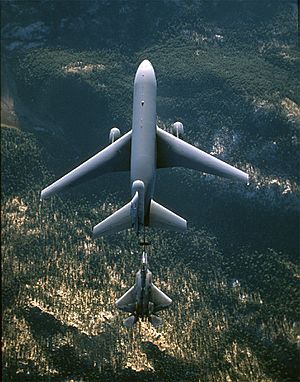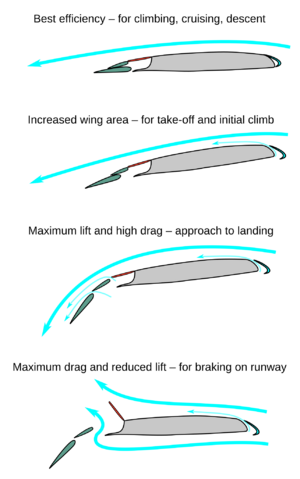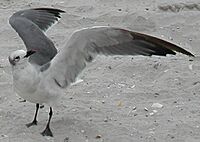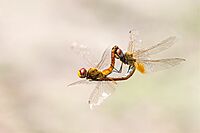Wing facts for kids

A wing is a special part that helps things fly or move through air or water. It creates a force called lift, which pushes the object up. Wings also create drag, which is air resistance.
Wings have two main features: their cross-section, called an airfoil, and their overall shape, called a planform. How well a wing works is measured by its lift-to-drag ratio. This compares how much lift it makes to how much air resistance it faces.
The study of how wings work in the air is called aerodynamics. Similar parts that move through water are called foils. You can find them on hydrofoil boats and foiling sailboats. These boats lift out of the water when they go fast. Submarines also use parts like wings, called diving planes, to move up or down underwater. The study of how foils work in water is called hydrodynamics.
Contents
What Does "Wing" Mean?
The word "wing" comes from an old Norse word, vængr. For a long time, it mostly meant the front limbs of birds. But over the years, its meaning grew. Now, it also describes the parts that help insects, bats, and pterosaurs fly. It also refers to the lifting parts on boomerangs, some sailboats, and aircraft. Even race cars have special wings to help them stick to the track.
How Do Wings Create Lift?

The way aircraft wings are designed and how they work is a big part of aerodynamics. This science is a branch of fluid mechanics, which studies how liquids and gases move.
For a wing to create lift, it needs to be tilted at the right angle of attack as air flows over it. When the wing is tilted, it pushes the air downwards. Because the wing pushes the air down, the air pushes the wing up. This upward push is what we call lift.
This force comes from different air pressures around the wing. The air pressure on top of the wing becomes lower than the air pressure below it. This difference in pressure creates the upward force. You can measure these pressure differences. You can also calculate them using Bernoulli's principle. This principle explains how air speed relates to air pressure.
The lower pressure on top of the wing creates a smaller downward force. The higher pressure on the bottom creates a stronger upward force. This combination results in the overall upward force on the wing, which is lift. Scientists can calculate lift in different ways, like from pressure differences or from how the air's direction changes. All these methods give the same answer if done correctly.
Wing Shapes and Flight
Most wings used for flying slower than the speed of sound have an asymmetrical (uneven) cross-section. Wings with a symmetrical (even) cross-section can also create lift. They do this by being tilted at a positive angle of attack to push air downwards.
Symmetrical wings need to fly faster to create enough lift. But they are great for aerobatic aircraft. This is because they work the same whether the plane is flying normally or upside down. Think of a sailboat's sail; it's a thin sheet that acts like a wing.
For planes flying near the speed of sound (transonic flight), special asymmetrical wing shapes are used. These are called supercritical airfoils. They are flatter on top and more curved on the bottom. This design helps reduce the big increase in drag that happens at these speeds.
Cool Wing Features
Aircraft wings often have special parts to help them fly better:
- A rounded front edge, called the leading edge.
- A sharp back edge, called the trailing edge.
- Devices on the front edge like slats or slots. These help increase lift at slower speeds.
- Devices on the back edge like flaps. These also help increase lift, especially during takeoff and landing.
- Winglets are small upward-curved tips at the end of the wing. They help reduce drag and improve efficiency.
- Dihedral means the wings angle slightly upward from the body. This makes the aircraft more stable. If they angle downward (anhedral), it makes them less stable.
Pilots use various devices on the wings to change their shape and size during flight:
- Ailerons are movable parts near the wingtips. They help the aircraft roll from side to side.
- Spoilers are panels on the top surface. They pop up to increase drag and reduce lift. This helps the plane slow down and puts more weight on the wheels for braking.
- Vortex generators are small fins that help keep the airflow smooth over the wing.
- Wing fences are small walls on the wing. They help keep the airflow attached to the wing.
- Folding wings allow planes to be stored in smaller spaces, like on an aircraft carrier.
- Variable-sweep wings, also called "swing wings," can change their angle. They can be spread out for slow flight (like takeoff or landing) and swept back for high-speed flight. Famous examples include the F-14 Tomcat and the Panavia Tornado.
Different Kinds of Wings
Wings come in many shapes and designs:
- Swept Wings: These wings angle backward from the plane's body.
- Variable Sweep Wings: These wings can change their angle during flight.
- Delta Wings: These wings are shaped like a triangle.
- Elliptical wings: These wings have a smooth, oval shape.
- Trapezoidal wings: These wings are wider at the base and narrower at the tip.
Where Else Are Wings Used?
Besides regular airplanes, wing shapes are used in many other ways:
- Hang gliders use wings that can be flexible or rigid to glide through the air.
- Kites use different lifting surfaces to fly in the wind.
- Flying model airplanes are smaller versions of aircraft.
- Helicopters use rotating wings (blades) that spin to create lift and move in different directions.
- Propellers have blades that are like small wings. They spin to create thrust and push the aircraft forward.
- The NASA Space Shuttle used its wings to glide back to a runway after re-entering Earth's atmosphere. These are called spaceplanes.
- Some racing cars, especially Formula One cars, use upside-down wings. These create a downward force (downforce) that helps the car stick to the track at high speeds.
- Sailboats use sails as vertical wings. They catch the wind to move the boat across the water.
Flexible Wings
In 1948, a person named Francis Rogallo invented a completely flexible wing. Later, Domina Jalbert created flexible, thick wings that filled with air, like those used in paragliders.
Wings in Nature
Wings have appeared many times in nature through evolution. We see them in insects, birds (which evolved from dinosaurs), bats, pterosaurs, and even some plants. Bird, bat, and pterosaur wings all developed from existing limbs. However, insect wings grew as a completely new structure. Wings helped animals move faster, spread to new places, and become more diverse.
Some birds, like penguins and other water birds such as auks and cormorants, are excellent swimmers. They use their wings to move powerfully through the water, almost like flying underwater!
- Wing forms in nature
-
A laughing gull, showing its wing shape
-
dragonflies mating in flight
See Also
In Nature:
- Bird flight
- Flight feather
- Flying and gliding animals
- Insect flight
- List of soaring birds
- Samara (winged seeds of trees)
In Aviation:
- Aircraft
- Flight dynamics (fixed-wing aircraft)
- Kite types
- Ornithopter – Aircraft that flap their wings
- Otto Lilienthal
- Wing configuration
- Wingsuit
In Sailing:
- Sails
- Forces on sails
- Wingsail
External Links
- How Wings Work - Holger Babinsky Physics Education 2003
- How Airplanes Fly: A Physical Description of Lift
- Demystifying the Science of Flight – Audio segment on NPR's Talk of the Nation Science Friday
- NASA's explanations and simulations
- Flight of the StyroHawk wing
- See How It Flies
Ala (zoología)







